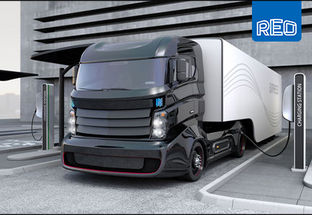TECHNOLOGICAL ADVANCEMENTS NEEDED FOR ELECTRIC TRUCKS
It’s well established that necessity is often the mother of invention. It is this idea that gave humans the wheel, to cart goods for further distances without tiring themselves out. Today, necessity has spurred the advancement of electric vehicles (EVs) and the move to electrify heavier vehicles such as trucks to reduce carbon emissions. Here, Steve Hughes, managing director of emobility power component expert REO UK, explains how we can keep electric truck technology on track.
One of the biggest considerations with electric trucks is their driving range. Due to being typically used for logistics and haulage, trucks often drive for longer distances and have more impending deadlines to meet than regular vehicles. However, a historic lag in EV uptake has meant that there is not currently adequate infrastructure for charging electric vehicles. Although this is a known problem that governments across the globe are working to address, it has created a pressing need for the technology of electric trucks to be efficient to extend the battery runtime for as long as possible.
One of the main ways that electric trucks extend battery energy is with regenerative braking. This involves recovering excess energy and feeding it back into other vehicle processes or systems, minimising losses and reducing the amount of power directly required from the battery. One study found that regenerative braking efficiency can reach up to 70 per cent, depending on the driver’s style of driving. Regenerative braking also reduces brake wear and tear, thus extending the life of vehicle components.
The key to regenerative braking is to ensure that the excess energy is looped back into the system safely. The resistors in the braking system protect the car from high voltage rises in the DC link, meaning that the excess energy will not overwhelm the system, but can be used productively.
During braking, thermal energy is one of the main excess energies produced and sources of losses. Making effective use of this in regenerative braking requires a braking resistor with good heat dissipation. The braking resistors offered by REO UK, for example, use water-cooling for increased heat dissipation, thus meaning that more energy can be reclaimed into processes such as heating.
Braking resistors also have an important part to play in allowing electric trucks to brake safely. For the electric truck to be able to have a safe stopping distance, braking resistors are needed, as excess braking could overload and potentially damage the system. Because of the increased torque needed the braking resistors required for an electric truck have to be able to manage a higher wattage than the ones needed in an electric car, such as the REO UK REOHM series 155, which offers a small footprint and large power capacity, ideal for larger vehicles.
Choosing the right components for electric trucks is essential, as without understanding how to maximise each component, electric trucks will fall by the wayside. The infrastructure needed for electric trucks is not yet mainstream, therefore to get electric trucks as a practical resource on the roads now, there needs to be a focus on the components that make up the electrical truck. The REO UK emobility document allows engineers to make sure that they are looking at the right components.
Infrastructure
Although the components that make up an electric truck are necessary to continue advancements, they are not the only important consideration. The infrastructure for electric trucks needs equal advancements for electric trucks to become more commonplace. The Government’s recent Net Zero strategy highlights the need for carbon neutral trucks, but does not mention how they will make the infrastructure around the UK more electric truck friendly.
Currently, the UK’s infrastructure readiness is cause for some concern. The Climate Change Committee has stated that, to meet targets, there needs to be 150,000 points operating by 2025. Yet according to the UK’s Labour party, only 15 per cent of that amount is in place, suggesting that these infrastructural advancements are needed urgently now.
Charging electric trucks can cause problems for the electrical grid through harmonic currents. Harmonics occur when charging electric trucks because frequencies can change within the electric distribution systems, which leads to voltage and current variations. This then leads to increased stress on the grid as more electricity is being demanded from it.
Harmonic distortions also cause damage to electrical network infrastructure and the trucks being charged. The distortions cause the wires of the electrical grid to overheat due to the excess electricity flowing through them, with this elevated temperature accelerating the wear and deterioration of components.
Electric trucks suffer a similar fate, as the additional stress of increased electricity can overheat capacitors and transformers. By not focusing on infrastructural issues, both the infrastructure that exists and the vehicles that are needed become damaged.
Fortunately, this can be prevented by using a high quality harmonic filter, which administers the counteracting frequencies in order to clean the distortion from the electrical signal. REO UK offers the CNW 897 harmonic filter, which increases network stability while also increasing the reliability of electrical installations. By fixing these infrastructural problems, the stress on engineers to maximise every component will be reduced.
Although charging infrastructure is not commonplace yet, it is important to note the difference types of charging available. Electric trucks have two different types of ‘fuel’ – AC and DC charging. AC charging can charge an electric truck in around 12 hours, so is more suited for overnight charging. DC charging can charge a truck faster, in around two hours, but by doing it too regularly can damage the battery as the current bypasses the onboard charging device. However, by offering even a few DC charging ports en route, trucks can quickly refill their battery.
To achieve widespread use of electric trucks, there needs to be charging infrastructure in place. Until this happens, extending the life of the batteries in the only way to get electric trucks on the road now. With electric trucks having the technology to allow them to recycle energy and maintain the battery integrity, there is the realistic possibility of electric trucks becoming more frequently seen on the road. By continuing advancements in electric vehicle design, there will be more opportunities for companies to make the switch now.













